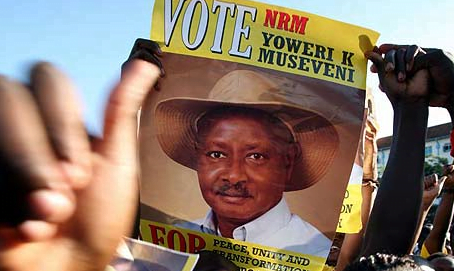KAMPALA, Uganda–As in many countries with Big Man leaders who refuse to quit their powerful (and lucrative) presidential or prime minister posts, it’s hard to go far in the Ugandan capital of Kampala without coming across a poster of the aging president Yoweri Museveni looking sprightly or a large bright yellow billboard proclaiming the virtues of his ruling National Resistance Movement (NRM).
Last week Museveni was ceremoniously ushered in for his fourth term, marking his twenty-fifth year-and-counting year at the helm of his country; the inauguration party, attended by newly re-crowned Nigerian president Goodluck Jonathan and a host of other presidents from across the continent, was overshadowed when several thousand Ugandans took to the streets to welcome home embattled opposition leader and thrice-defeated presidential candidate Kizza Besigye, who had been recovering in Nairobi after being sprayed in the eyes with tear gas by arguably overzealous police attempting to stop his new “Walk to Work” movement–a series of protests against rising food and fuel protest by the discontent and growing poor citizenry.
The visual omnipresence of the ruling party in the streets of Kampala is more than just psychological browbeating of the ruling party by its largely disenfranchised populace. Most Ugandans I’ve met accept that Musveni is firmly entrenched whether they like it or not; regardless of their views of Besigye, the conventional wisdom suggest that the old Big Man will not go without a fight (a disconcerting sign given the events this year in sub-Saharan Africa’s neighbors to the north). Instead, Museveni’s NRM seems to be making an argument to Ugandans, a rationale for why the president refuses to cede power after a quarter-century. One bright yellow billboard festooned with Museveni’s face read: “28 rebel movements have been defeated since 1986. Enjoy your peace and make it work for you.”
Making it work is indeed what Ugandans must do to get by, despite the dozens of billboards I saw with other news of the infrastructure, health, education, and so on improvements made during Museveni’s tenure–all these signs carried the explicit rationale that the ruling party has done a lot and will do a lot more, but only under Museveni’s superb leadership.
I am not in the shoes of an everyday Ugandan citizen, but after seeing the NRM’s PR approach prominently on display, I am inclined to think that 25 years is a long time, so building some few thousand kilometers of paved roads during this time period is not an extraordinary achievement–in fact, it is the responsibility of any government in an underdeveloped post-conflict country such as Uganda. I also take issue with the assertion that continued progress and development is only possible under Museveni’s rule, as if things would grind to a halt under a younger, less authoritarian and perhaps more innovative president.
The notion of “continuation,” generally pitched as “we are not done yet, give us more time to fulfill our lofty promises,” is a theme I saw last month in the campaigns of many Nigerian politicians. In those cases, and in the case of the NRM in Uganda, I’m hard pressed to see how another few years of Museveni’s presidency will exponentially improve the quality of life for his citizens. (That being said, opposition leader Besigye has not yet made a compelling case for why he is different.)
Like its neighbors–and let’s be honest, many countries on this continent–everyday Ugandans deserve better leadership than the current dispensation provides. From the perspective of Ugandan citizens and in terms of regional stability in East Africa and the Horn, the coming months could be pivotal in Uganda, for better or for worse.
